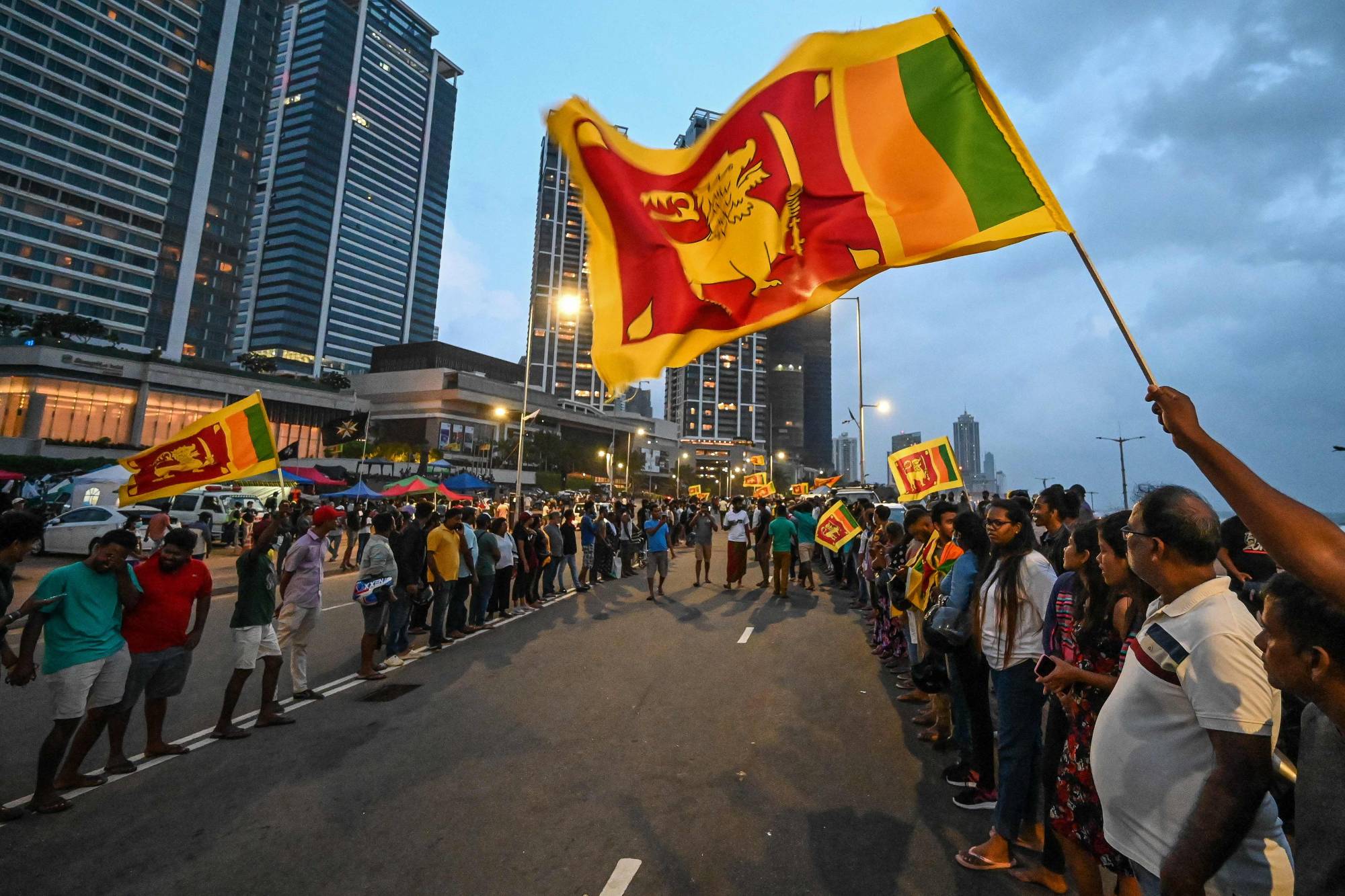Sri Lanka had its own moment of the ‘Arab Spring’ during April 2022 when the masses overthrew the autocratic rule, highlighting the rampant corruption and rising poverty. On July 9, protesters stormed into the presidential palace and set Prime Minister’s House on fire. By 13th of July, Gotabaya Rajapaksa fled the country on a military aircraft, shortly sending his resignation letter.
The first protests at the President’s house and Galle Face had a ripple effect on the entire island. The government labelling the protesters as extremists and the police shooting in Rabukkana and attacking peaceful protestors at the protest site had only aggravated the situation. The regime’s immediate family members and financiers fled the country as the dissenting mob burned their properties.
Sri Lanka, in April 2022, defaulted on a multi-million dollar’s worth of foreign debt, i.e., US$ 51 billion to foreign creditors, thereby was declared bankrupt by several international financial watchdogs and by the central government itself. The then-emerging financial crisis paved the way for overthrowing the sitting government ruled by the Rajapaksa familial dynasty. Ranil Wickremesinghe (who was also sworn in as the interim President) has taken over the political reigns have turned to every nook and corner for help so as to prevent the ongoing crisis, which is said to be the worst of any crisis the country has faced since its independence.
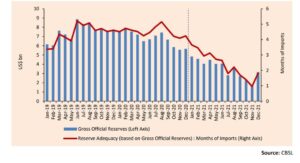
Fig. Graph representing declining national reserves. Source: Central Bank of Sri Lanka
Importance of foreign currency
Foreign exchange stock is an essential commodity for the economic functioning of a nation since it is used for payment for import commodities. Sri Lanka is highly dependent on its tourism industry and faced an economic catastrophe during the worldwide lockdown due to the COVID-19 pandemic. On previous occasions, Sri Lanka also suffered economically due to the LTTE presence until 2008, when it slowly began to open up to the world. By 2019, the tourism industry faced another of a shocker due to the deadly Easter bombings in Colombo. By early 2020, it had closed down its international borders, fearing a surge of COVID cases in the region.
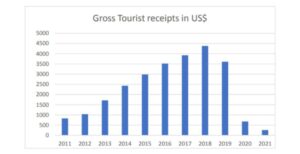
Source: Central Bank of Sri Lanka
Causes of Financial Crisis
Poor Tax Reforms: Under the Rajapaksa government, the state made multiple modifications to its taxation mandate so as to align with the IMF requirements to avail foreign loans. These included increased tax-free thresholds that resulted in a 33.5% decline in registered taxpayers, reducing VAT to 8%, reducing corporate tax from 28% to 24%, the abolishment of the Pay As You Earn (PAYE) tax, and the 2% “nation-building tax” which financed infrastructure development in the country. These changes led to a steep decline in the government’s tax collection leading to the depletion of foreign currency, often utilized to purchase oil and other import items. Additionally, it led to the downgrading of the country’s credit status, making it difficult for Sri Lanka to avail of added foreign loans.
External Debt Crisis: Previous governments have borrowed from external sources to fund the infrastructural development in the country. Sri Lanka’s foreign debt witnessed a multi-fold increase, from constituting 42% of GDP in 2019 to upwards of 119% by 2021. This meant that Sri Lanka had more to pay than all of its economic contribution, leading the country to declare bankruptcy. Many experts have pointed out China’s “debt trap” as a reason for Sri Lanka’s surge in external debt liabilities.
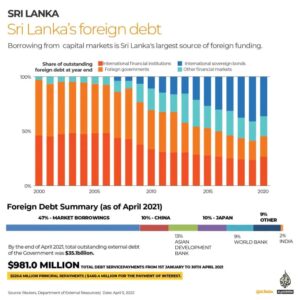
Source: Al Jazeera
Decline in Remittances: Due to the constant fluctuation of the Sri Lankan Rupee (SLR), citizens working abroad often choose to remit money through third-party channels, leading to a steep decline in the remittance collection of the government. By January 2022, the government collected 61 % lesser remittances than the previous year. This led to a shortage of foreign currency stock that was often exchanged for USD so as to build its USD stick that would be utilized to buy import commodities in the international market.
Agricultural Policies: Under the Rajapaksa government, Sri Lanka introduced a transition to organic farming means, and several policies were drafted to catalyze the shift, such as banning inorganic fertilizers and agrochemicals-based fertilizers. This led to a decline in the domestic production of rice and tea, two of the major export commodities of Sri Lanka. The lack of export sales cost the government around US$ 800 million, leading to a halt in the foreign currency collection for the year.
Russia-Ukraine War: Due to globalized sanctions, Sri Lanka could not export its tea to Russia, the second-largest importer of Sri Lankan teas. Moreover, due to its tropical weather and well-established tourism infrastructure, Sri Lanka used to be an essential hub for Russian tourists. The war has led to multiple airline cancellations and visa issues, leading to a decline in Russian tourist arrival.
Ramifications of the Crisis
Power Outage: Due to currency shortage, Sri Lanka could not pay for the import of coal stock, leading to a hastened depletion of its coal reserve stock. Many power plants had to be kept shut, resulting in a nationwide power shortage. Some power plants are resorting to hydro energy using the waters used for irrigation purposes. Due to insufficient rains and increased use of reservoirs for the power plants, water shortage is anticipated, which, as per experts, will badly affect agricultural production and may lead to the food crisis in an already commodity-inflated market.
Fuel Shortage: The forex crisis has led to fuel shortages across the country. It has affected household gas supply, commercial fuel required to run supply chain across various industries and at the social level where individuals could not make essential travel to workplaces, medical institutes, etc., due to lack of petrol/diesel across the nation. Flight services have dwindled down to their minimal capacity affecting the critical tourism industry.
Commodity Price Inflation: Things of basic necessities have witnessed a surge of up to 50 percent, leaving the struggling middle class to survive on a day-to-day basis. While the economy had not even made the bare minimum recovery from the pandemic, several households which lost jobs during the lockdown have resorted to nationwide protests or have begun to flee to other countries as refugees.
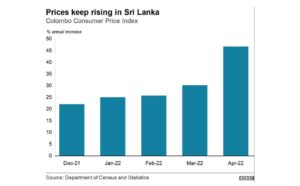
Fig. Prices for essential commodities faced a 50% rise by April 2022; Source: BBC
Nationwide Protests: In March 2022, spontaneous and organized protests by both political parties and non-partisan groups over the government’s mishandling of the economy were reported across the country, with protestors demanding the resignation of the sitting government. Several thousand in numbers joined the protests, especially outside President’s residence in Colombo, and had vandalized various high-profile ministers’ houses. Rajapaksa family had to flee under military protection, and police had resorted to tear gas and water cannons to curb the insinuating mob violence.
Way Forward
The Sri Lankan government has already planned a short-term strategy to bail the country out of its imposing problems. It has struck deals with India, China, and the EU for emergency aid and essential supplies, while at the same time, talks are ongoing with IMF for further monetary support to the country. The country still lacks a long-term plan and struggles to put up a road map, for now, awaiting future problems. No policies regarding agriculture and taxation have taken place, which was the two significant sources of the present economic crisis. This can lead the masses to give up on their hopes of ever coming out of the political turmoil.
Many may resort to fleeing the country as economic refugees to other countries such as Malaysia, Australia, etc. Some may resort to overthrowing the current government and bringing back the direct military rule across the nation. A country that has struggled to bring democratic institutions to find a ground in its political functioning may give up on democracy altogether. Neighbouring countries such as India, Bangladesh, etc., and the US and EU need to step up their efforts in treading the nation back to its feet. Global North, for the time being, has its eyes affixed on the Ukrainian crisis, while countries in Global South like Sri Lanka struggle to provide the basic necessities to its masses.
Image – AFP

